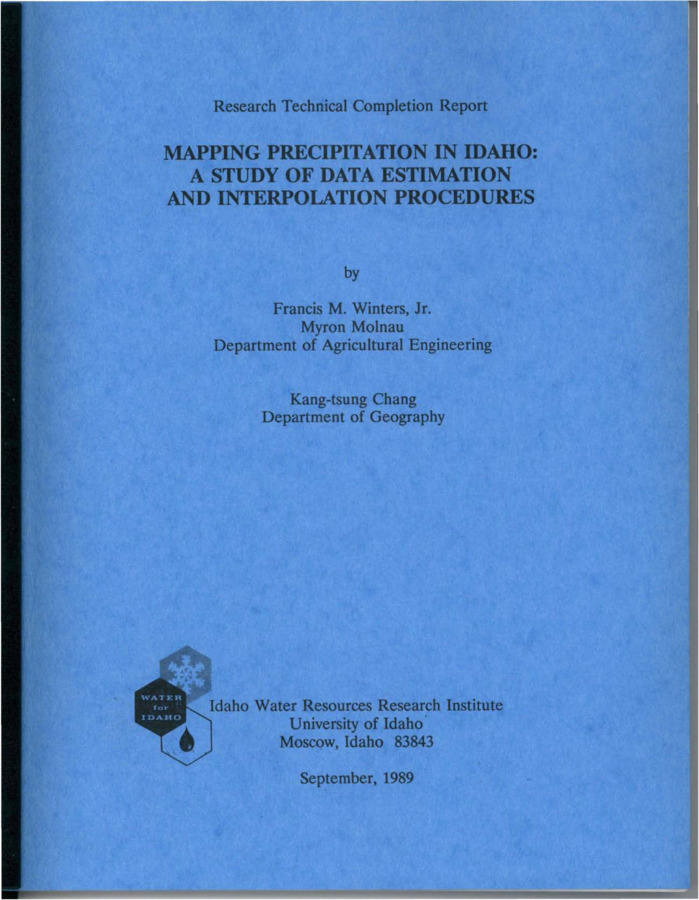PDF
Mapping precipitation in Idaho: a study of data estimation and interpolation procedures. Research technical completion report, 14-08-0001-G1559-32 Item Info
- Title:
- Mapping precipitation in Idaho: a study of data estimation and interpolation procedures. Research technical completion report, 14-08-0001-G1559-32
- Authors:
- Winters Jr., Francis M.; Molnau, Myron; Chang, Kang-tsung
- Date:
- 1989-09
- Description:
- As the competition for Idaho's available water has increased, increased attention has been paid to the amount and distribution of precipitation in Idaho. To adequately manage this valuable resource, a good understanding of the precipitation pattern is essential. In particular, a new map of mean annual precipitation is needed. The current map was based primarily on data from low-lying weather stations. Since its completion, new data have shown this map to be inaccurate, especially at high elevations where new data from the SNOTEL network are now available. A new series of mean annual precipitation maps at a scale of 1:250,000 is now being drawn. A computer contouring procedure is used to create the preliminary maps with the final maps being manually drawn. The database used is the National Weather Cooperative Network and the Soil Conservation Service SNOTEL stations. All data records were gathered and standardized to the 1961-1985 base period. Next, multiple regression equations were developed to estimate point precipitation values where no gages exist. Third, point interpolation procedures were investigated as to their appropriateness for use on the data set. Either the normal ratio method or multiple regression was used to derive missing values. Acceptable estimates were made for all missing data. Multiple regression equations for point precipitation data were derived to estimate precipitation in between locations of snow precipitation. The final equations were of the form log(MAP) = f(elevation, location, air mass lifting index). An equation was derived for each of seven regions. Acceptable estimation equations were derived for all but two of these regions. For the automated production of preliminary isohyets, two point interpolation procedures were examined. The advantages and limitations of the inverse distance method and the punctual Kriging procedure were investigated.
- Subjects:
- precipitation mapping maps computer models
- Collection:
- IWRRI
- Series:
- Water for Idaho
- Source:
- Idaho Water Resources Research Institute, University of Idaho
- Identifier:
- IWRRI Number 198909
- Publisher:
- Idaho Water Resources Research Institute, University of Idaho
- Contributing Institution:
- University of Idaho
- Type:
- Text
- Format:
- application/pdf
- Cataloger:
- KIT
- Date Digitized:
- 2017-09-11
- Language:
- eng
Source
- Preferred Citation:
- "Mapping precipitation in Idaho: a study of data estimation and interpolation procedures. Research technical completion report, 14-08-0001-G1559-32", Idaho Waters Digital Library, University of Idaho Library Digital Collections, https://www.lib.uidaho.edu/digital/iwdl/items/iwdl-198909.html
Rights
- Rights:
- In copyright, educational use permitted. Educational use includes non-commercial reproduction of text and images in materials for teaching and research purposes. For other contexts beyond fair use, including digital reproduction, please contact the University of Idaho Library Special Collections and Archives Department at libspec@uidaho.edu. The University of Idaho Library is not liable for any violations of the law by users.
- Standardized Rights:
- http://rightsstatements.org/vocab/InC-EDU/1.0/

